基本翻译理论
相关翻译理论和翻译技巧
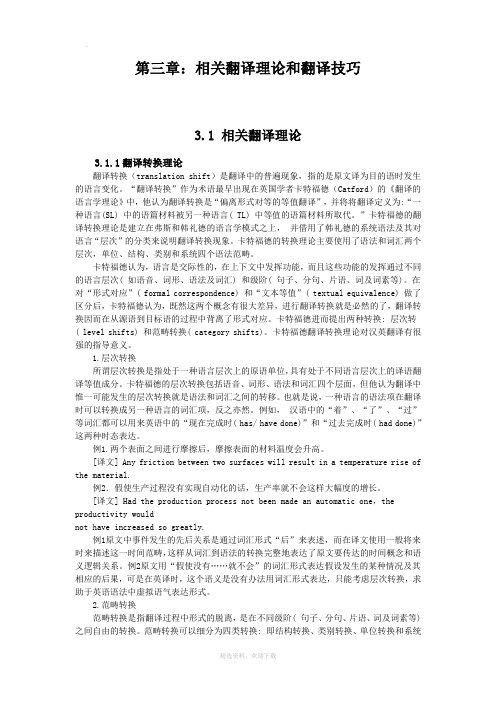
第三章:相关翻译理论和翻译技巧3.1 相关翻译理论3.1.1翻译转换理论翻译转换(translation shift)是翻译中的普遍现象,指的是原文译为目的语时发生的语言变化。
“翻译转换”作为术语最早出现在英国学者卡特福德(Catford)的《翻译的语言学理论》中,他认为翻译转换是“偏离形式对等的等值翻译”,并将将翻译定义为:“一种语言(SL) 中的语篇材料被另一种语言( TL) 中等值的语篇材料所取代。
”卡特福德的翻译转换理论是建立在弗斯和韩礼德的语言学模式之上,并借用了韩礼德的系统语法及其对语言“层次”的分类来说明翻译转换现象。
卡特福德的转换理论主要使用了语法和词汇两个层次,单位、结构、类别和系统四个语法范畴。
卡特福德认为,语言是交际性的,在上下文中发挥功能,而且这些功能的发挥通过不同的语言层次( 如语音、词形、语法及词汇) 和级阶( 句子、分句、片语、词及词素等)。
在对“形式对应”( formal correspondence) 和“文本等值”( textual equivalence) 做了区分后,卡特福德认为,既然这两个概念有很大差异,进行翻译转换就是必然的了,翻译转换因而在从源语到目标语的过程中背离了形式对应。
卡特福德进而提出两种转换: 层次转( level shifts) 和范畴转换( category shifts)。
卡特福德翻译转换理论对汉英翻译有很强的指导意义。
1.层次转换所谓层次转换是指处于一种语言层次上的原语单位,具有处于不同语言层次上的译语翻译等值成分。
卡特福德的层次转换包括语音、词形、语法和词汇四个层面,但他认为翻译中惟一可能发生的层次转换就是语法和词汇之间的转移。
也就是说,一种语言的语法项在翻译时可以转换成另一种语言的词汇项,反之亦然。
例如,汉语中的“着”、“了”、“过”等词汇都可以用来英语中的“现在完成时( has/ have done)”和“过去完成时( had done)”这两种时态表达。
彼得纽马克的所有翻译理论

语义对等性的实现方法
为了实现语义对等性,译者需要深入理解原文的语境、词汇和语法结构,同时还需要考虑目标语言的表达习惯和文化背景。
语义对等性
语义翻译与交际翻译的区别
语义翻译更注重原文的形式和内容,力求保持原文的语义和句法结构,而交际翻译则更注重译文的交际效果,强调译文的流畅性和可读性。
语义翻译与交际翻译的联系
交际翻译的对等性
彼得纽马克认为,交际翻译和语义翻译并不是相互独立的,而是相互补充的。
在翻译过程中,需要根据文本的类型和功能选择适当的翻译方法。对于信息型文本,如新闻报道、科技文献等,应该采用语义翻译方法,以准确地传达原文的信息;对于表达型文本,如诗歌、散文等,应该采用交际翻译方法,以使译文更符合目标语言的表达习惯和文化背景。
04
文化翻译理论
VS
彼得纽马克认为,文化翻译是一种将源语言中的文化信息传达给目标语言读者的过程,其原则包括保持源语言的文化特色、尊重目标读者的文化背景和审美习惯。
详细描述
彼得纽马克认为,文化翻译的主要目的是在目标语言中再现源语言的文化特色和内涵,以促进不同文化之间的交流和理解。为了实现这一目的,文化翻译应遵循以下原则:保持源语言的文化特色,尊重目标读者的文化背景和审美习惯,以及在必要时对原文进行适当的调整或注释。
在实际翻译中,两种方法常常需要结合使用,以确保译文既忠实于原文的内容和风格,又能够有效地传达原文的信息和功能。
01
02
03
交际翻译与语义翻译的关系
优点
交际翻译强调译文的交际效果,能够使译文更符合目标语言的表达习惯和文化背景,使读者更容易理解和接受。同时,交际翻译的对等性要求也提高了译文的准确性和可读性。
直译的定义与原则
直译的原则
第四章--翻译理论常识简介
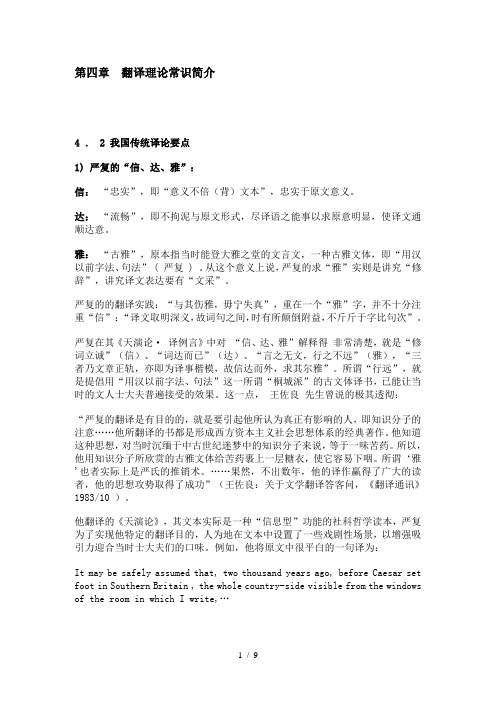
第四章翻译理论常识简介4 . 2 我国传统译论要点1) 严复的“信、达、雅”:信:“忠实”,即“意义不倍(背)文本”,忠实于原文意义。
达:“流畅”,即不拘泥与原文形式,尽译语之能事以求原意明显,使译文通顺达意。
雅:“古雅”,原本指当时能登大雅之堂的文言文,一种古雅文体,即“用汉以前字法、句法” ( 严复 ) 。
从这个意义上说,严复的求“雅”实则是讲究“修辞”,讲究译文表达要有“文采”。
严复的的翻译实践:“与其伤雅,毋宁失真”,重在一个“雅”字,并不十分注重“信”:“译文取明深义,故词句之间,时有所颠倒附益,不斤斤于字比句次”。
严复在其《天演论· 译例言》中对“信、达、雅”解释得非常清楚,就是“修词立诚”(信)、“词达而已”(达)、“言之无文,行之不远”(雅),“三者乃文章正轨,亦即为译事楷模,故信达而外,求其尔雅”。
所谓“行远”,就是提倡用“用汉以前字法、句法”这一所谓“桐城派”的古文体译书,已能让当时的文人士大夫普遍接受的效果。
这一点,王佐良先生曾说的极其透彻:“严复的翻译是有目的的,就是要引起他所认为真正有影响的人,即知识分子的注意……他所翻译的书都是形成西方资本主义社会思想体系的经典著作。
他知道这种思想,对当时沉缅于中古世纪迷梦中的知识分子来说,等于一味苦药。
所以,他用知识分子所欣赏的古雅文体给苦药裹上一层糖衣,使它容易下咽。
所谓‘雅'也者实际上是严氏的推销术。
……果然,不出数年,他的译作赢得了广大的读者,他的思想攻势取得了成功”(王佐良:关于文学翻译答客问,《翻译通讯》1983/10 )。
他翻译的《天演论》,其文本实际是一种“信息型”功能的社科哲学读本,严复为了实现他特定的翻译目的,人为地在文本中设置了一些戏剧性场景,以增强吸引力迎合当时士大夫们的口味。
例如,他将原文中很平白的一句译为:It may be safely assumed that, two thousand years ago, before Caesar set foot in Southern Britain , the whole country-side visible from the windows of the room in which I write,…赫胥黎独处一室之中,在英伦之南,背山而面野。
翻译理论(汉译英)
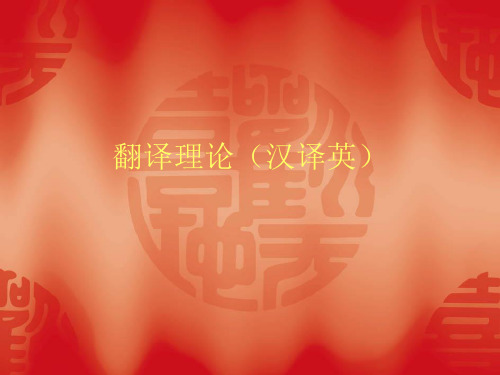
六、表示谚语的无主句英译时可译为无主句,
亦可译为人称句,要视情况而定 a)三思而后行。 First think,then speak. b)入乡随俗 When in Rome,do as the Romans do. c)活到老,学到老。 One is never too old to learn. d)不入虎穴,焉得虎子。 He who would search for pearls must dive deep.Nothing venture, nothing have.
翻译理论(汉译英)
第一章汉语单句句型的翻译(一)
第一节 无主语的译法 无主句,顾名思义,就是没有主语的句子。
英语中除谚语外,只有省略了主语的祈使句为 无主句。而汉语中无主句却比比皆是,一般用 来表示自然现象、命令、谚语、存现、叙述等 意义。汉语的无主句翻译时常采用下列方式: 一、表示自然现象,时间,距离的无主句一般 译作英语的无人称句 英语的无人称句由“代词it”作主语,其表意 功能与汉语表自然现象、时间、距离的无主句 相同,翻译时常可对译。如:
汉语的动词无词形变化,而英语的非限定动词有不 定式与分词的区别,翻译英中必须注意宾补动词形式 的运用。“使、令”类兼语式的宾补多为不定式, 有的动词只能用分词作宾朴,有的不定式,分词皆 有,意思不同,须加区别使用。 如: a)不要让你妈一直等你。 Don't keep your mother waiting. b)这话使我们都笑了。 The words set us all laughing c)他觉得房子在摇动。 He felt the house shaking 1)当动词是“keep,catch,set,feel”等时。宾补 动词应用现在分词以表进行中的动作。
翻译基础理论和技巧

2)学习翻译理论掌握翻译技巧的必要性
There are many translation theories and techniques. Without knowing the theories and techniques, one will most likely take a roundabout course in the translation work.That is why it is necessary for us to have a good command of both the source language and the target language, and of the theories and techniques in translation.
3)了解翻译技巧的局限性
必须指出:翻译技巧是人们从事多年翻 译工作的经验总结,应该认真学习。然 而, 翻译技巧只告诉我们在某些具体情 况下翻译应该使用的技巧,因此有其局 限性。
如:
用词不同 black tea、black coffee、 an off season 词的搭配不同 make money、wet snow、a heavy snow 语解过程
表达过程
M -------------- TO ---------- MR
(SL)
(TL)
MR: reproduced message
SL:source language
TL:target language
倘若乙是个英(美)国人,不懂汉语, 甲是个中国人又不懂英语,甲乙之间 就不能交流思想。这时,就需要丙把 甲所说的或所写的信息用英语重新表 达一遍,成为再现信息(reproduced message)。这样,乙就明白了甲的意 思,交流就完成了。在这个过程中, 丙担任了翻译的角色。通过翻译进行 的思想交流,叫做:语际交流 (interlingual communication)。
纽马克的翻译理论主要是什么

纽马克的翻译理论主要是什么彼得•纽马克是英国著名的翻译理论家和翻译教育家。
纽马克在分析和总结各家各派的翻译思想的基础上,将文体论、话语分析、符号学、格语法的理论、功能语法和跨文化交际理论应用于翻译理论和研究,对于翻译理论、翻译教学、翻译语言学以及翻译技巧都进行了精辟的论述。
纽马克翻译理论的核心是语义翻译和交际翻译,这也是其翻译理论中最主要、最有特色的组成部分。
他的代表作包括《翻译问题探索》(Approaches to Translation, 1981) 、《翻译教程》(A T extbook of Translation, 1988)、《翻译论》(About Translation, 1991)和《翻译短评》(Paragraphs on Translation, 1993)。
在《翻译问题探索》一书中,纽马克提出,针对不同的文本类型应当采用不同的翻译方法——语义翻译(s emantic translation) 或交际翻译(communicative translation)。
根据不同的内容和文体,他将文本分为抒发功能(expressive function)、信息功能(inform ative function)、呼唤功能(vocative function)、审美功能(aesthetic functio n)、应酬功能(phatic function)和元语言功能(metalingual function)。
20世纪90年代他又提出“关联翻译法”,这标志着他的翻译理论渐趋系统。
下面本文将就纽马克的主要译论观点进行初步解读,以求对纽马克的翻译理论做更深层次的理解,并将相关翻译标准应用到英汉、汉英翻译中去。
一.语言功能与文本类型纽马克认为,翻译活动即是对文本的翻译,研究翻译不能离开文本。
在修正布勒(Buhler)、雅各布森(Jakobson)功能模式的语言理论基础上,根据不同的内容和文体,纽马克提出了一套自己的文本功能及其分类。
翻译理论(英译汉)
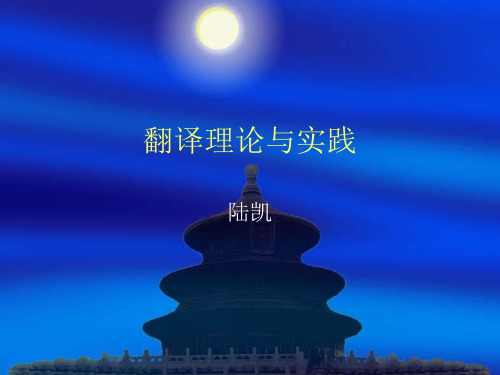
❖ (1)When the boy came back, the old man was asleep in the chair and the sun went down
❖ 孩子回来的时候,老头儿已在椅子上睡着,太阳已经西 沉了。
❖ (2)He was bending his head down,his right hand tightly clenched upon the edge of the bench.
❖ 再比如“past”这个词: ❖ (1)The days are past when Jewish blood could be
shed with impunity. ❖ 可以不受惩罚地屠杀犹太人的时代已一去不复返。
❖ (2)The old man sitting in a chair is a past president. ❖ 坐在椅子上的那位老人是一位卸任的总统。 ❖ (以上两例中past是形容词) ❖ (3)There was no question that Chrysler had a
(8)Time appears to run more slowly for a moving clock than for a clock at rest.
对于正在运动的时钟来说,时间似乎过得比静止的时 钟慢些。
(9)A fifty foot navy boat was waiting at the dock,its diesel motors running.
现在一切取决于我们打这手牌时是否冷静而审 慎。
(6)The clock hands pointed to ten minutes after five.
翻译的六大理论
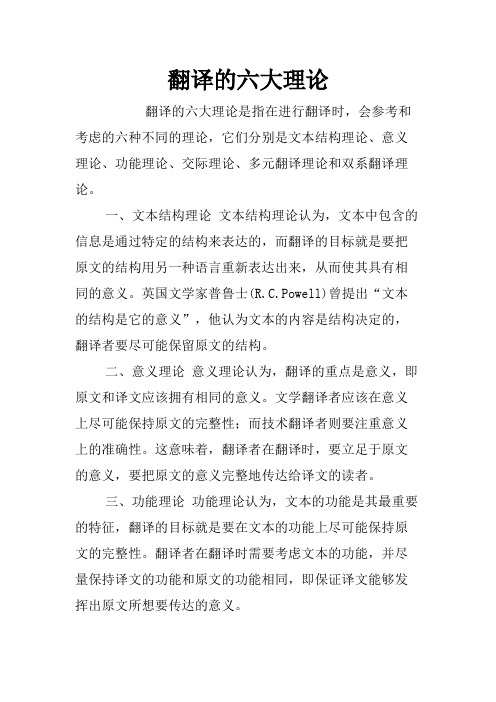
翻译的六大理论翻译的六大理论是指在进行翻译时,会参考和考虑的六种不同的理论,它们分别是文本结构理论、意义理论、功能理论、交际理论、多元翻译理论和双系翻译理论。
一、文本结构理论文本结构理论认为,文本中包含的信息是通过特定的结构来表达的,而翻译的目标就是要把原文的结构用另一种语言重新表达出来,从而使其具有相同的意义。
英国文学家普鲁士(R.C.Powell)曾提出“文本的结构是它的意义”,他认为文本的内容是结构决定的,翻译者要尽可能保留原文的结构。
二、意义理论意义理论认为,翻译的重点是意义,即原文和译文应该拥有相同的意义。
文学翻译者应该在意义上尽可能保持原文的完整性;而技术翻译者则要注重意义上的准确性。
这意味着,翻译者在翻译时,要立足于原文的意义,要把原文的意义完整地传达给译文的读者。
三、功能理论功能理论认为,文本的功能是其最重要的特征,翻译的目标就是要在文本的功能上尽可能保持原文的完整性。
翻译者在翻译时需要考虑文本的功能,并尽量保持译文的功能和原文的功能相同,即保证译文能够发挥出原文所想要传达的意义。
四、交际理论交际理论认为,翻译是一种交际行为,译文应当有效地满足读者的需求,这意味着,翻译者在翻译时,要考虑到读者的文化背景和知识水平,要尽量使译文能够被读者理解和接受。
五、多元翻译理论多元翻译理论认为,翻译不是一个简单的过程,而是一个复杂的过程,它涉及到语言、文化、历史、社会等多种因素。
翻译者要充分考虑各种因素,并尽量把原文的含义准确地传达给译文的读者。
六、双系翻译理论双系翻译理论认为,译文既要把原文的含义准确地传达给读者,又要确保译文的艺术性和可读性,从而使译文尽可能成为一种可接受的作品。
因此,翻译者在翻译时,不仅要考虑原文的内容,还要考虑译文的艺术性和可读性,从而使译文更加准确、生动、接近原文。
总而言之,翻译的六大理论是文本结构理论、意义理论、功能理论、交际理论、多元翻译理论和双系翻译理论,它们都是翻译工作中必不可少的理论,翻译者应当熟知这些理论,从而更好地完成翻译工作。
- 1、下载文档前请自行甄别文档内容的完整性,平台不提供额外的编辑、内容补充、找答案等附加服务。
- 2、"仅部分预览"的文档,不可在线预览部分如存在完整性等问题,可反馈申请退款(可完整预览的文档不适用该条件!)。
- 3、如文档侵犯您的权益,请联系客服反馈,我们会尽快为您处理(人工客服工作时间:9:00-18:30)。
Basic Knowledge of Translation TheoryI.Translation1.Definition1)The definition in the old days●“译即易,谓换易言语使相解也。
”——贾公彦(618-907) 唐朝●“夫翻译者,谓翻梵天之语转成汉地之言。
音虽似别,义则大同。
”——法云(960-1279) 宋代It means that translation is a rendering from one language (Source Language) into another (Target Language), remaining the meaning.●The British scholar Dr. Samuel Johnson once said: “To translate is to change intoanother language, remaining the sense.”2)The current definition●The American translation theorist Eugene A. Nida wrote in 1964: Translationconsists in reproducing in the receptor language the closest natural equivalence of the source language, first in terms of meaning and secondly in terms of style.(所谓翻译,是在译语中用切近而又最自然的对等语再现原语的信息,首先是意义,其次是文体。
)1)再现原文的信息(message)而不是保留原文的形式结构(formal structure)2)对等(equivalence)不是同一(identity)3)对等是最贴近、自然的对等4)意义是优先考虑的因素5)文体很重要●The British translation theorist Tytler’s definition in 1970 about translation: “Agood translation is one which the merit of the original work is so completely transfused into another language as to be as distinctly apprehended and as strongly felt by a native of the country to which that language belongs as it is by those who speak the language of the orig inal work.”●Prof. Huang Long TranslatologyTranslation may be defined as follows:The replacement of textual material in one language (SL) by equivalent textual material in another language (TL)(翻译可以作以下界定:用一种语言(目的语)的文本材料对等地再现另一种语言(源出语)的文本材料。
)1)部分地替代2)对等概念In summary1)Translation is the information transferring between two languages and thecultural communication between two language families.2)Translation is a rendering from one language into another. Translation is ascience, an art, a bilingual art, a craft, a skill, an operation andcommunication.3)Translation is a representation or recreation in one language of what iswritten or said in another language.4)Translation is a kind of science because it was a whole set of rules governingit and certain objective laws to go by in the process of translating.2.Varieties of translation1)Interpretation and written translation2)In terms of SL and TL, Interlingual translation语际(不同语言之间),Intralingual translation语内(同一语言rewording),Intersemiotic translation符际(eg.把语言符号用图画、手势、数字或音乐来表达)3)In terms of style, political essay政论,practical writing应用文,science andtechnology科技,literary translationII.Translation Criteria or Principle●Tytler’s: Essay on the Principles of Translation, 17911) A translation should give a complete transcript of the ideas of theoriginal work.译文应完全复写出原作的思想。
2)The style and manner of writing should be of the same character asthat of the original.译文的风格和笔调应与原文的性质相同。
3) A translation should have all the ease of the original composition.译文应和原作同样流畅。
●Yanfu’s: Faithfulness, Expressiveness and Elegance (信、达、雅)1.“Faithfulness” means the full and complete conveying of theoriginal content of thought.2.“Expressiveness” demands that the vers ion should be clear andflowing without any grammatical mistakes or confused logic andsense.3.“Elegance” refers to the use of classical Chinese before the HanDynasty.In summary, the first two words as translation criteria are acceptable.The original mea ning of “Elegance” is unacceptable for today, but we cangive it new sense -----elegant style in translation.●Others:Lu Xun’s (鲁迅)translation principle:Rather be faithful (in thought) than smooth (in language) in opposition toLiang Shi-qiu’s translation principle in 1930s. (宁信不顺)Fu Lei’s付雷translation criteria: TL should be similar to SL both in Formand in Spirit. (形似、神似)Liu C hongde’s刘重德translation criteria: faithfulness, expressiveness andcloseness. (信、达、切) faithfulness: to be faithful to the content of theoriginal; expressiveness: to be as expressive and smooth as the original;closeness: to be as close to the original style as possible.Liang Shiqiu ‘s and Zhao Jingshen’s (梁实秋,赵景深) translationprinciple in 1930s: “It’s better to have a smooth version than a faithful one.”宁错务顺Eugene A. Nida’s translation principle: Dynamic equivalence orFunctional equivalence or Equivalent-effect theory. The main idea is thatthe translator is to produce as nearly possible the same effect on his readersas was produced on the readers of the original.Peter Newmark’s translation principle: From the angle of contextualanalysis, he puts forward two translation approaches: Semantic translationand Communicative translation.Semantic translation: The translator attempts, within the bare syntactic andsemantic constraints of the TL, to produce the precise contextual meaning ofthe author. Semantic translation focuses primarily upon the semantic contentof the source text.Communicative translation: The translator attempts to produce the sameeffect on the TL readers as was produced by the original on the SL readers.Communicative translation focuses essentially upon the comprehension andresponse of receptors.In summary, translation criteria: faithfulness and smoothness忠实与通顺.Faithfulness refers to that content and style of TL should be faithful to theSL.Smoothness requires that version should be clear and distinct, flowingand easy to read without signs of the mechanical word-for-wordtranslation, of obscure language, of grammatical mistakes, confusedstructure and logic.III.Prerequisites of a translatorAs Zhou En-lai said: To be a good translator we should strengthen our “basic training” in the three essential aspects:1)The enhancement of our political consciousness2)The betterment of our command of the relevant languages3)The broadening of the range and scope of our general knowledge. IV.Translation strategies: foreignization and domesticationForeignization:If the translator’s preference is placed on preserving the language and cultural differences of the Source Text, we call this kind of approaches or its translation foreignizing or foreignization.Domestication:It refers the method or practice of adapting the translation to the norms and values of the Target Language and culture is called domesticating or domestication.For example,C-E谋事在人,成事在天。
